Effect of Vegetation Restoration on Soil Humus and Aggregate Stability within the Karst Region of Southwest China
Abstract
1. Introduction
2. Materials and Methods
2.1. Research Area
2.2. Sample Collection
2.3. Sample Determination
2.3.1. Determination of Soil Physical and Chemical Properties
2.3.2. Extraction and Determination of Humus Components
2.3.3. Data Processing and Analysis
2.3.4. Statistical Analysis
3. Results and Analysis
3.1. Basic Soil Physical and Chemical Properties
3.2. Distribution and Stability Characteristics of Soil Aggregates
3.3. Stability Characteristics of the Aggregates under Different Crushing Mechanisms
3.4. Soil Humus Fraction Characteristics
3.4.1. Humic Acid (HA) and Fulvic Acid (FA) Contents and Their Distribution Ratio
3.4.2. Changes in the Precipitation Quotient (PQ) Value of Soil Aggregates
3.4.3. Humin (HM) Content and Its Distribution Ratio
3.5. Analysis of the Correlation and Regression between Aggregate Characteristics and Soil Humus Components
4. Discussion
4.1. Effect of Vegetation Restoration on Soil Aggregates
4.2. Effects of Vegetation Restoration on Soil Humus Components
4.3. Influence of the Humus Components on Aggregate Stability
5. Conclusions
Author Contributions
Funding
Data Availability Statement
Acknowledgments
Conflicts of Interest
References
- Sheng, M.; Xiong, K.; Wang, L.; Li, X.; Li, R.; Tian, X. Response of soil physical and chemical properties to rocky desertification succession in South China Karst. Carbonates Evaporites 2018, 33, 15–28. [Google Scholar] [CrossRef]
- Wang, S.; Liu, Q.; Zhang, D. Karst rocky desertification in southwestern China: Geomorphology, landuse, impact and rehabilitation. Land Degrad. Dev. 2004, 15, 115–121. [Google Scholar] [CrossRef]
- Sun, Y.; Zhang, Y.; Li, S.; Zhang, N.; Wang, J. Research progress on soil and water loss and soil and water conservation in Karst areas. In Proceedings of the 2019 International Academic Exchange Conference on Science and Technology Innovation, Guangzhou, China, 20–22 December 2019; pp. 235–238. [Google Scholar]
- Walker, L.R.; Walker, J.; Hobbs, R.J. Linking Restoration and Ecological Succession; Springer: Berlin/Heidelberg, Germany, 2007. [Google Scholar]
- Gong, J.; Chen, L.; Fu, B.; Huang, Z.; Peng, H. Effect of land use on soil nutrients in the loess hilly area of the Loess Plateau. Land Degrad. Dev. 2006, 17, 453–465. [Google Scholar] [CrossRef]
- Chen, L.; Wang, J.; Wei, W.; Fu, B.; Wu, D. Effects of landscape restoration on soil water storage and water use in the Loess Plateau Region, China. Forest Ecol. Manag. 2010, 259, 1291–1298. [Google Scholar] [CrossRef]
- Wang, B.; Liu, G.; Xue, S.; Zhu, B. Changes in soil physico-chemical and microbiological properties during natural succession on abandoned farmland in the Loess Plateau. Environ. Earth Sci. 2011, 62, 915–925. [Google Scholar] [CrossRef]
- Yang, L.; Wei, W.; Chen, L.; Jia, F.; Mo, B. Spatial variation of shallow and deep soil moisture in the semi-arid loess hilly area. Hydrol. Earth Syst. Sci. Discuss. 2012, 9, 4553–4586. [Google Scholar]
- Stockmann, U.; Padarian, J.; Mcbratney, A.; Minasny, B.; Brogniez, D.; Montanarella, L.; Hong, S.Y.; Rawlins, B.G.; Field, D.J. Global soil organic carbon assessment. Global Food Secur. 2015, 6, 9–16. [Google Scholar] [CrossRef]
- Batjes, N.H. Harmonized soil property values for broad-scale modelling (WISE30sec) with estimates of global soil carbon stocks. Geoderma 2016, 269, 61–68. [Google Scholar] [CrossRef]
- Grinhut, T.; Hertkorn, N.; Schmitt-Kopplin, P.; Hadar, Y.; Chen, Y. Mechanisms of humic acids degradation by white rot fungi explored using 1H NMR spectroscopy and FTICR mass spectrometry. Environ. Sci. Tec. 2011, 45, 2748–2754. [Google Scholar] [CrossRef]
- Ponge, J.F.; Sartori, G.; Garlato, A.; Ungaro, F.; Zanella, A.; Jabiol, B.; Obber, S. The impact of parent material, climate, soil type and vegetation on Venetian forest humus forms: A direct gradient approach. Geoderma 2014, 226, 290–299. [Google Scholar] [CrossRef]
- Brady, N.C. The Nature and Properties of Soils, 8th ed.; MacMillan Publishing Co.: New York, NY, USA, 1984. [Google Scholar]
- Mikutta, R.; Kleber, M.; Torn, M.S.; Jahn, R. Stabilization of soil organic matter: Association with minerals or chemical recalcitrance? Biogeochemistry 2006, 77, 25–56. [Google Scholar] [CrossRef]
- Cheng, M.; Xiang, Y.; Xue, Z.; An, S.; Darboux, F. Soil aggregation and intra-aggregate carbon fractions in relation to vegetation succession on the Loess Plateau, China. Catena 2015, 124, 77–84. [Google Scholar] [CrossRef]
- Rattan, L. Physical management of soils of the tropics: Priorities for the 21st century. Soil Sci. 2000, 165, 191–207. [Google Scholar]
- Six, J.; Bossuyt, H.; Degryze, S.; Denef, K. A history of research on the link between (micro) aggregates, soil biota, and soil organic matter dynamics. Soil Till. Res. 2004, 79, 7–31. [Google Scholar] [CrossRef]
- Zhu, G.; Shangguan, Z.; Deng, L. Soil aggregate stability and aggregate-associated carbon and nitrogen innatural restoration grassland and Chinese red pine plantation on the Loess Plateau. Catena 2017, 149, 253–260. [Google Scholar] [CrossRef]
- Dou, Y.; Yang, Y.; An, S.; Zhu, Z. Effects of different vegetation restoration measures on soil aggregate stability and erodibility on the Loess Plateau, China. Catena 2020, 185, 104294. [Google Scholar] [CrossRef]
- Delgado, A.; Gómez, J.A. The soil. Physical, chemical and biological properties. In Principles of Agronomy for Sustainable Agriculture; Springer: Berlin/Heidelberg, Germany, 2017; pp. 15–26. [Google Scholar]
- Tisdal, J.M.; Oades, J.M. Organic matter and water-stable aggregates. Eur. J. Soil Sci. 1982, 33, 141–163. [Google Scholar] [CrossRef]
- Zhou, X.; Peng, X.; Peth, S.; Xiao, T.Q. Effects of vegetation restoration on soil aggregate microstructure quantified with synchrotron-based micro-computed tomography. Soil Till. Res. 2012, 124, 17–23. [Google Scholar] [CrossRef]
- Tang, Y.; Zhang, X.; Yang, P.; Wang, J.; Zhou, N. Fractal characteristics and stability of soil aggregates in karst rocky desertification areas. Nat. Hazards 2013, 65, 563–579. [Google Scholar] [CrossRef]
- Gelaw, A.M.; Singh, B.R.; Lal, R. Organic carbon and nitrogen associated with soil aggregates and particle sizes under different land uses in Tigray, Northern Ethiopia. Land Degrad. Dev. 2015, 26, 690–700. [Google Scholar] [CrossRef]
- Bronick, C.J.; Lal, R. Soil structure and management: A review. Geoderma 2005, 124, 3–22. [Google Scholar] [CrossRef]
- Six, J.; Paustian, K. Aggregate-associated soil organic matter as an ecosystem property and a measurement tool. Soil. Biol. Biochem. 2014, 68, A4–A9. [Google Scholar] [CrossRef]
- Dou, S.; Li, K.; Guang, S. A review on organic matter in soil aggregates. Acta Pedol. Sin. 2011, 48, 412–418. (In Chinese) [Google Scholar]
- Six, J.; Conant, R.T.; Paul, E.A.; Paustian, K. Stabilization mechanisms of soil organic matter: Implications for C-saturation of soils. Plant Soil 2002, 241, 155–176. [Google Scholar] [CrossRef]
- Lützow, M.V.; Knabner, I.K.; Ludwig, B.; Matzner, E.; Flessa, H.; Ekschmitt, K.; Guggenberger, G.; Marschner, B.; Kalbitz, K. Stabilization mechanisms of organic matter in four temperate soils: Development and application of a conceptual model. J. Plant Nutr. Soil Sci. 2008, 171, 111–124. [Google Scholar] [CrossRef]
- Li, G.; Fu, Y.; Li, B.; Zheng, T.; Wu, F.; Peng, G.; Xiao, T. Micro-characteristics of soil aggregate breakdown under raindrop action. Catena 2018, 162, 354–359. [Google Scholar] [CrossRef]
- Mao, X. Accumulation Characterisitcs and Stabilization Mechinisms of Organic Carbon in Soils Developed from Different parent Materials in Subtropical Regions; Zhejiang University: Hangzhou, China, 2020. (In Chinese) [Google Scholar]
- Sarker, T.C.; Incerti, G.; Spaccini, R.; Piccolo, A.; Mazzoleni, S.; Bonanomi, G. Linking organic matter chemistry with soil aggregate stability: Insight from 13C NMR spectroscopy. Soil Biol. Biochem. 2018, 117, 175–184. [Google Scholar] [CrossRef]
- Tan, W.; Xu, Y.; Shi, Z.; Cai, P.; Huang, Q. The formation process and stabilization mechanism of soil aggregates driven by binding materials. Acta Pedol. Sin. 2023, 60, 1297–1308. (In Chinese) [Google Scholar]
- Klučáková, M.; Kalina, M. Composition, particle size, charge, and colloidal stability of pH-fractionated humic acids. J. Soils Sediments 2015, 15, 1900–1908. [Google Scholar] [CrossRef]
- Jovanović, U.D.; Marković, M.M.; Cupać, S.B.; Tomić, Z.P. Soil humic acid aggregation by dynamic light scattering and laser Doppler electrophoresis. Eur. J. Soil Sci. 2013, 176, 674–679. [Google Scholar] [CrossRef]
- Cao, Z.; Wang, Y.; Li, J.; Zhang, J.; He, N. Soil organic carbon contents, aggregate stability, and humic acid composition in different alpine grasslands in Qinghai-Tibet Plateau. J. Mt. Sci-Engl. 2016, 13, 2015–2017. [Google Scholar] [CrossRef]
- Rodrigues, P.M.S.; Schaefer, C.E.G.R.; Silva, J.D.O.; Júnior, W.G.F.; Santos, R.M.D.; Neri, A.V. The influence of soil on vegetation structure and plant diversity in different tropical savannic and forest habitats. J. Plant Ecol. 2018, 11, 226–236. [Google Scholar] [CrossRef]
- Zhang, C.; Liu, G.; Xue, S.; Zhang, C. Rhizosphere soil microbial properties on abandoned croplands in the Loess Plateau, China during vegetation succession. Eur. J. Soil Biol. 2012, 50, 127–136. [Google Scholar] [CrossRef]
- Zhang, Y.; Shangguan, Z. The coupling interaction of soil water and organic carbon storage in the long vegetation restoration on the Loess Plateau. Ecol. Eng. 2016, 91, 574–581. [Google Scholar] [CrossRef]
- Mitter, B.; Brader, G.; Afzal, M.; Compant, S.; Naveed, M.; Trognitz, F.; Sessitsch, A. Advances in elucidating beneficial interactions between plants, soil and bacteria. Adv. Agron. 2013, 121, 381–445. [Google Scholar]
- Yu, Y.; Du, H.; Song, T.; Peng, W.; Zeng, F.; Wang, K.; Lu, S.; Fan, F.; Lu, C. Characteristics of soil fertility in different ecosystems in depressions between karst hills. Acta Ecol. Sin. 2013, 33, 7455–7466. [Google Scholar]
- Gallo, M.; Amonette, R.; Lauber, C.; Sinsabaugh, R.L.; Zak, D.R. Microbial community structure and oxidative enzyme activity in nitrogenamended north temperate forest soils. Microb. Ecol. 2004, 48, 218–229. [Google Scholar] [CrossRef]
- Zhao, D. Evolvement Characteristics and Quantification of Soil Aggregate Microstructure in the Process of Vegetation Restoration in Loess Hilly-Gully Region; Research Center of Soil and Water Conservation and Ecological Environment, Chinese Academy of Sciences and Ministry of Education: Beijing, China, 2017. (In Chinese) [Google Scholar]
- An, S.S.; Darboux, F.; Cheng, M. Revegetation as an efficient means of increasing soil aggregate stability on the Loess Plateau (China). Geoderma 2013, 209–210, 75–85. [Google Scholar] [CrossRef]
- Wu, G.; Liu, Z.; Zhang, L.; Chen, J.; Hu, T. Longterm fencing improved soil properties and soil organic carbon storage in an alpine swamp meadow of western China. Plant Soil 2010, 332, 331–337. [Google Scholar] [CrossRef]
- Lu, R. Methods of Soil and Agro-Chemistry Analysis; China Agricultural Science and Technology Press: Beijing, China, 2000. (In Chinese) [Google Scholar]
- Le Bissonnais, Y. Aggregate stability and assessment of soil crustability and erodibility: I. Theory and methodology. Eur. J. Soil Sci. 1996, 47, 425–437. [Google Scholar] [CrossRef]
- Li, C.; Cao, Z.; Chang, J.; Zhang, Y.; Zhu, G.; Zong, N.; He, Y.; Zhang, J.; He, N. Elevational gradient affect functional fractions of soil organic carbon and aggregates stability in a Tibetan alpine meadow. Catena 2017, 156, 139–148. [Google Scholar] [CrossRef]
- Zhang, B.; Horn, R. Mechanisms of aggregate stabilization in Ultisols from subtropical China. Geoderma 2001, 99, 123–145. [Google Scholar] [CrossRef]
- Le Bissonnais, Y.; Prieto, I.; Roumet, C.; Nespoulous, J.; Metayer, J.; Huon, S.; Villatoro, M.; Stokes, A. Soil aggregate stability in mediterranean and tropical agroecosystems: Effect of plant roots and soil characteristics. Plant Soil 2018, 424, 303–317. [Google Scholar] [CrossRef]
- Wang, B. Key Factors and Calculation of Soil Erodibility in the Typical Eroded Black Soil Area of Northeast China; Northwest A & F University: Xianyang, China, 2009. (In Chinese) [Google Scholar]
- Cavani, L.; Ciavatta, C.; Gessa, C. Identification of organic matter from peat, leonardite and lignite fertilisers using humification parameters and electrofocusing. Bioresour. Technol. 2003, 86, 45–52. [Google Scholar] [CrossRef]
- Aranda, V.; Oyonarte, C. Characteristics of organic matter in soil surface horizons derived from calcareous and metamorphic rocks and different vegetation types from the Mediterranean high-mountains in SE Spain. Eur. J. Soil Biol. 2006, 42, 247–258. [Google Scholar] [CrossRef]
- Su, Y.; Wang, F.; Zhang, Z.; Du, M. Soil properties and characteristics of soil aggregate in marginal farmlands of oasis in the middle of Hexi corridor region, Northwest China. Agr. Sci. China 2007, 6, 706–714. [Google Scholar] [CrossRef]
- Yoder, R.E. A direct method of aggregate analysis of soils and a study of the physical nature of erosion losses. J. Am. Soc. Agron. 1936, 17, 165. [Google Scholar] [CrossRef]
- Wang, J.; Liu, Z.; Bao, E.; Zhang, G.; Li, Y.; Sun, J. Effects of forest and grass restoration on soil aggregates and its organic carbon in karst rocky desertification areas. J. Soil Water Conserv. 2019, 33, 249–256. (In Chinese) [Google Scholar]
- Zheng, F. Effect of vegetation changes on soil erosion on the loess plateau. Pedosphere 2006, 16, 420–427. [Google Scholar] [CrossRef]
- Li, X.; Chen, X.; Zhou, L.; Jiao, C.; Cheng, S. Characteristics of soil iron and its pedogenetic significance in the process of karst rocky desertification, Southwestern China. Geol. Bull. China 2010, 29, 745–751. (In Chinese) [Google Scholar]
- Wang, J. Effects on Soil Anti-Erodibility and Soil Organic Matter Frations in Slope Farmlands with Different De-Farming Patterns in South Sichuan Province of China; Sichuan Agricultural University: Ya’an, China, 2011. (In Chinese) [Google Scholar]
- Zhang, Z.; Pan, G.; Zhang, J. Features on the humin composition in Xialaxiu profile. Res. Soil Water Conserv. 2013, 20, 295–298+304. (In Chinese) [Google Scholar]
- Wang, D. Several Zonal Soils Organic Matter Composition and Its Relationships with Structural Stability; Huazhong Agricultural University: Wuhan, China, 2017. (In Chinese) [Google Scholar]
- Chen, S. Stability of Soil Aggregates under Different Land Use Patterns and Its Relationships with Organic Matter and Iron-Aluminum Oxides; Huazhong Agricultural University: Wuhan, China, 2012. (In Chinese) [Google Scholar]
- Rice, J.A.; MacCarthy, P. Disaggregation and characterization of humin. Sci. Total Environ. 1992, 117–118, 83–88. [Google Scholar] [CrossRef]
- Haynes, R.J.; Beare, M.H. Influence of six crop species on aggregate stability and some labile organic matter fractions. Soil Biol. Biochem. 1997, 29, 1647–1653. [Google Scholar] [CrossRef]
- Hayes, M.H.B.; Mylotte, R.; Swift, R.S. Humin: Its composition and importance in soil organic matterses. Adv. Agron. 2017, 143, 47–138. [Google Scholar]
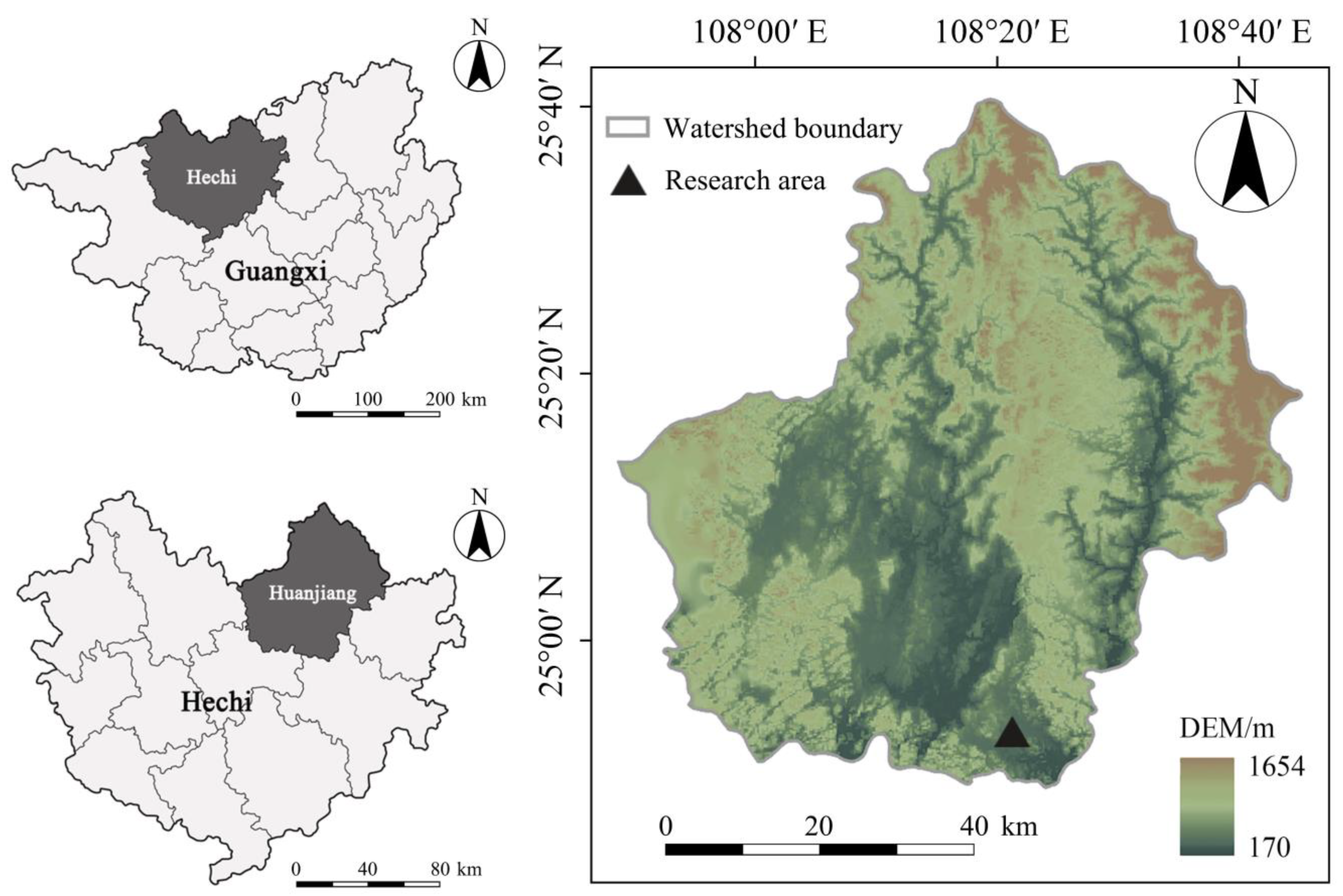

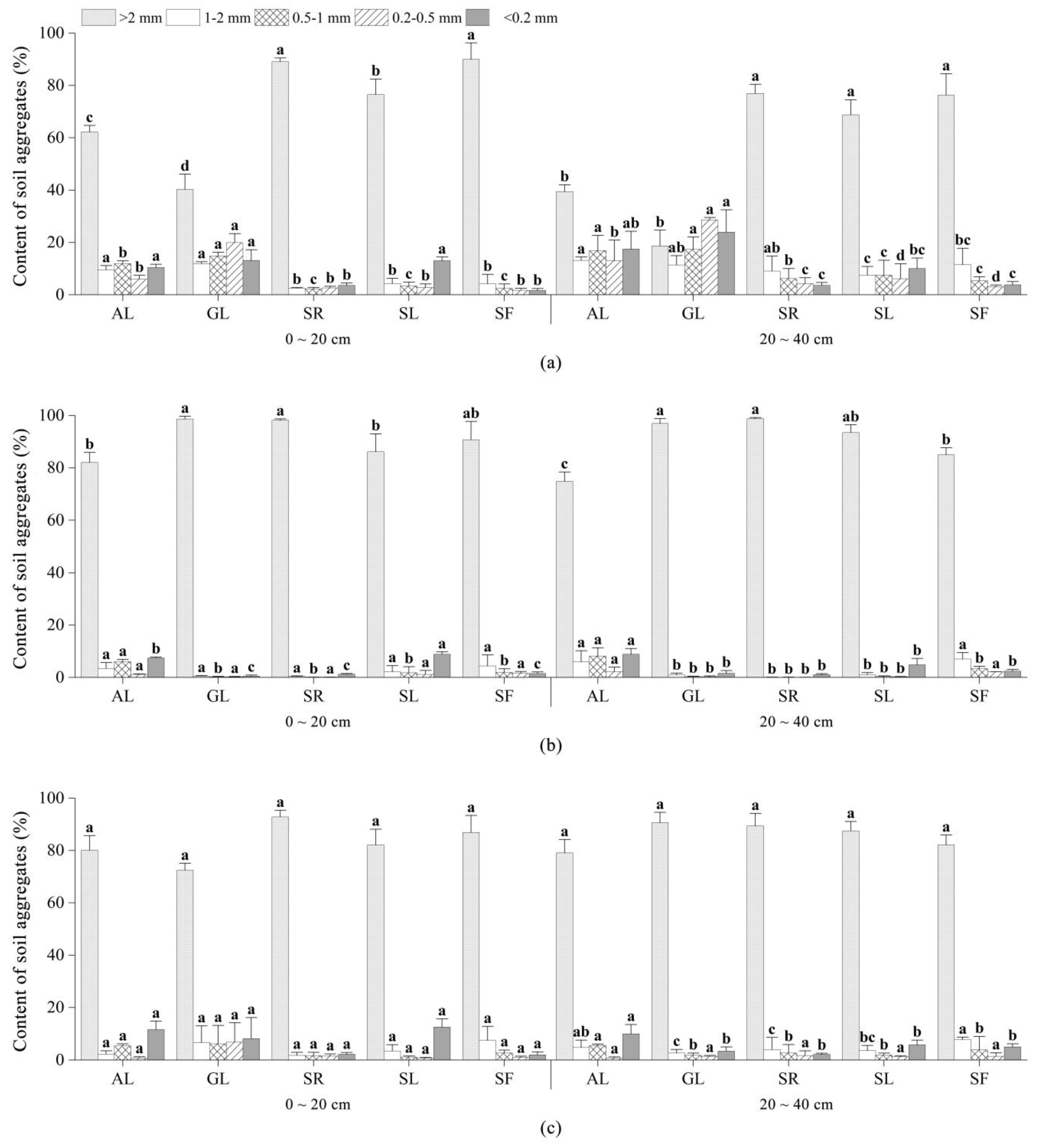
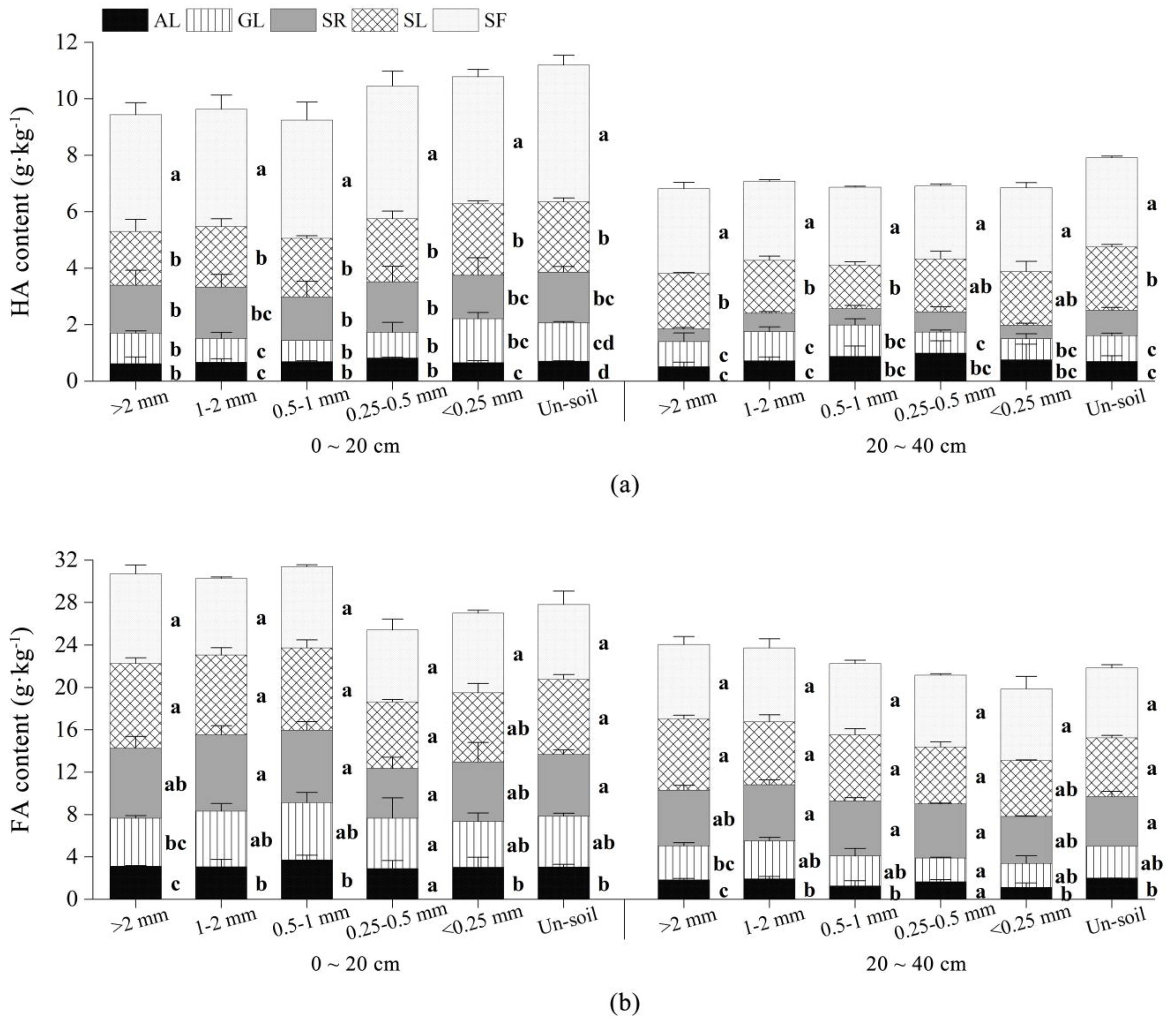

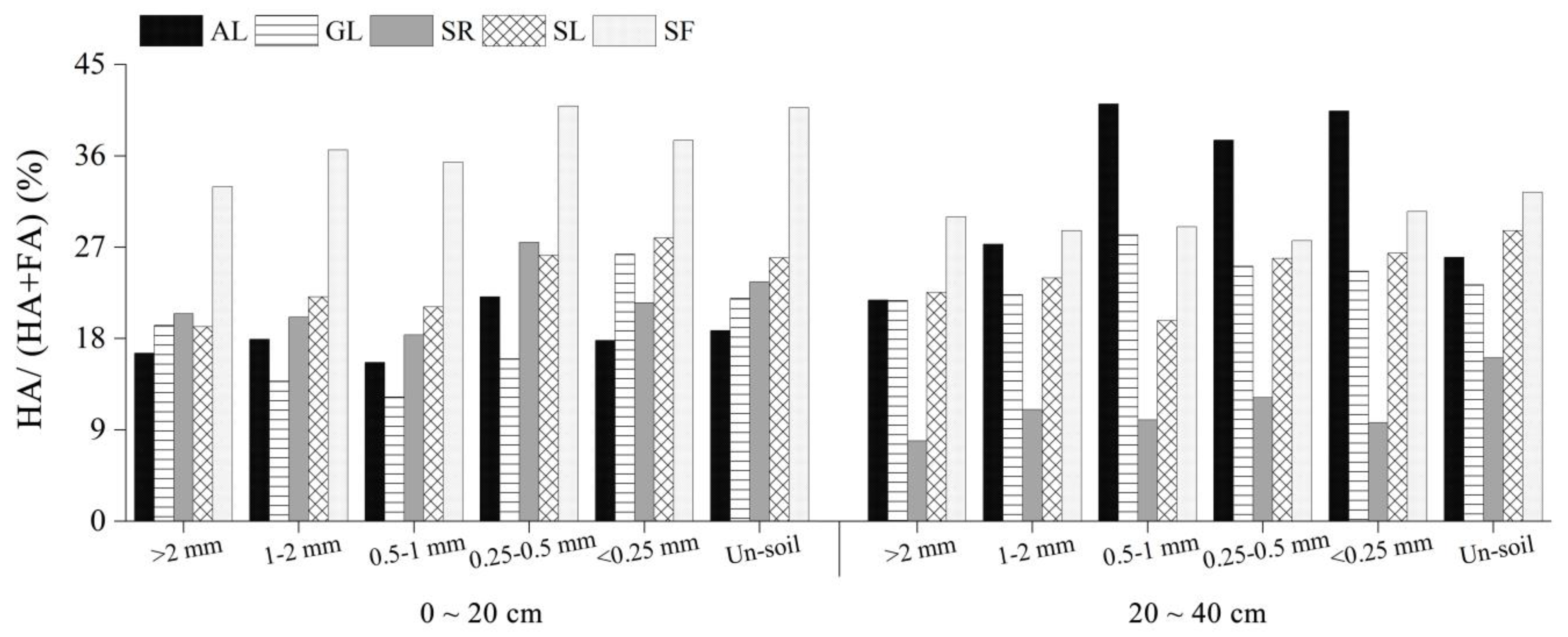
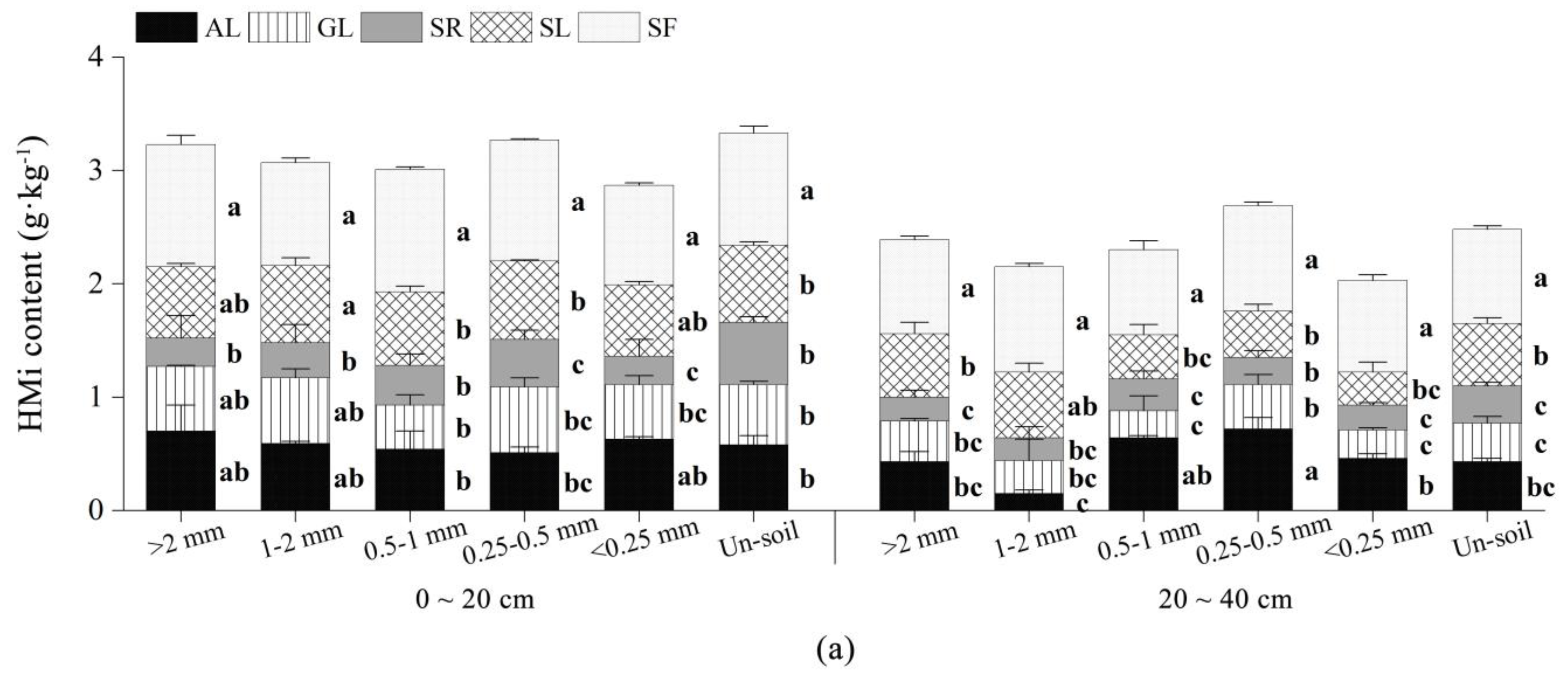
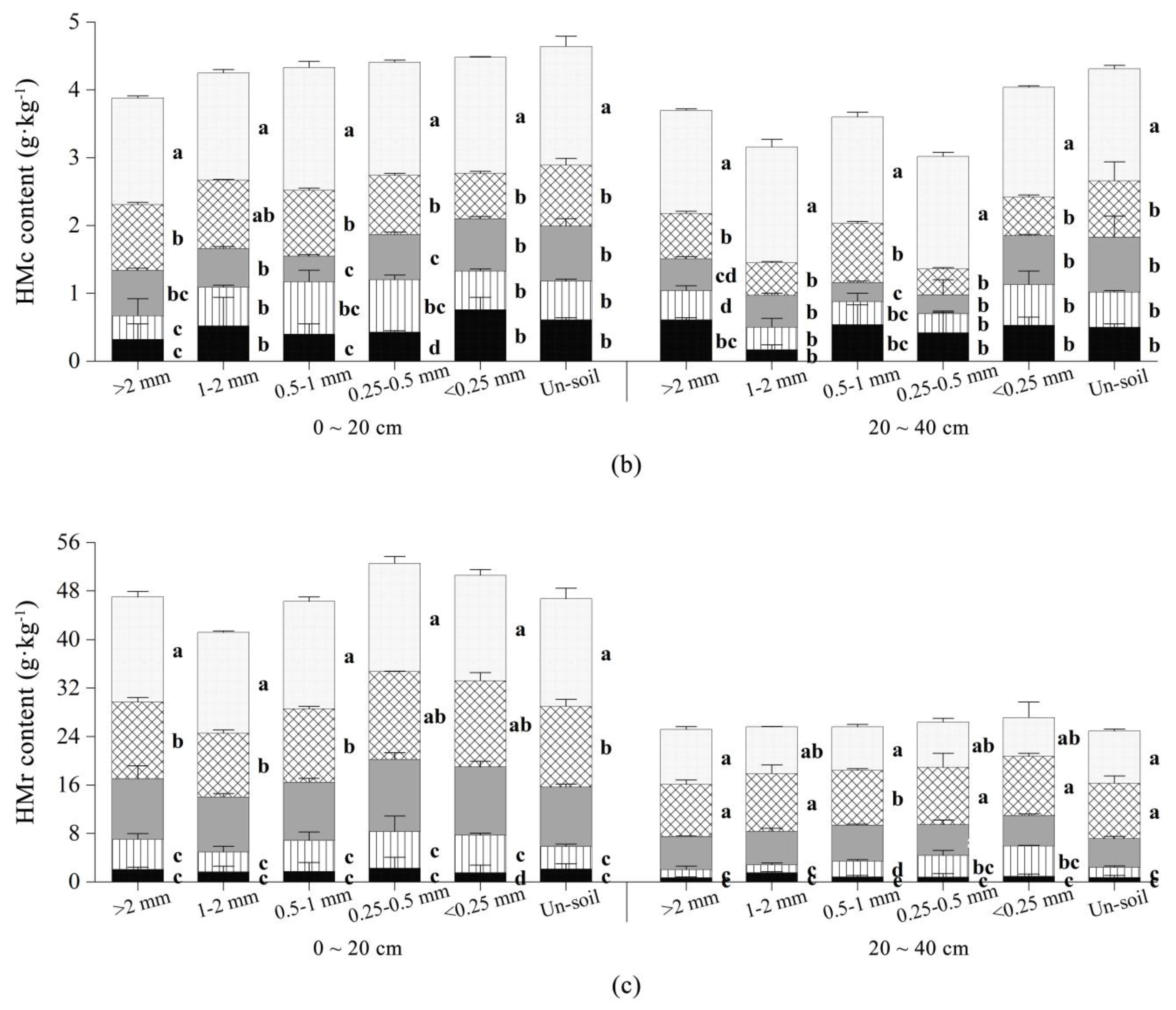
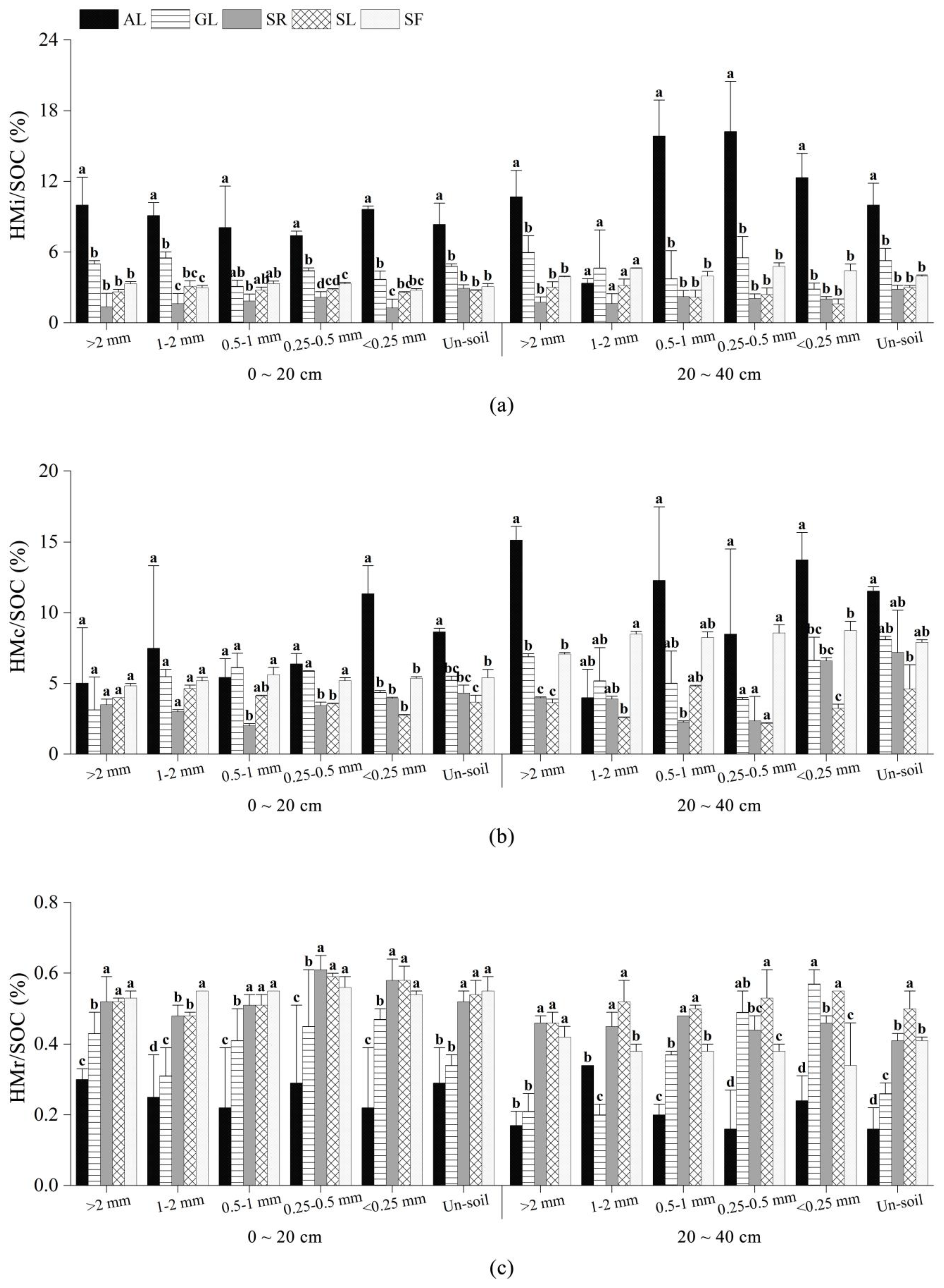
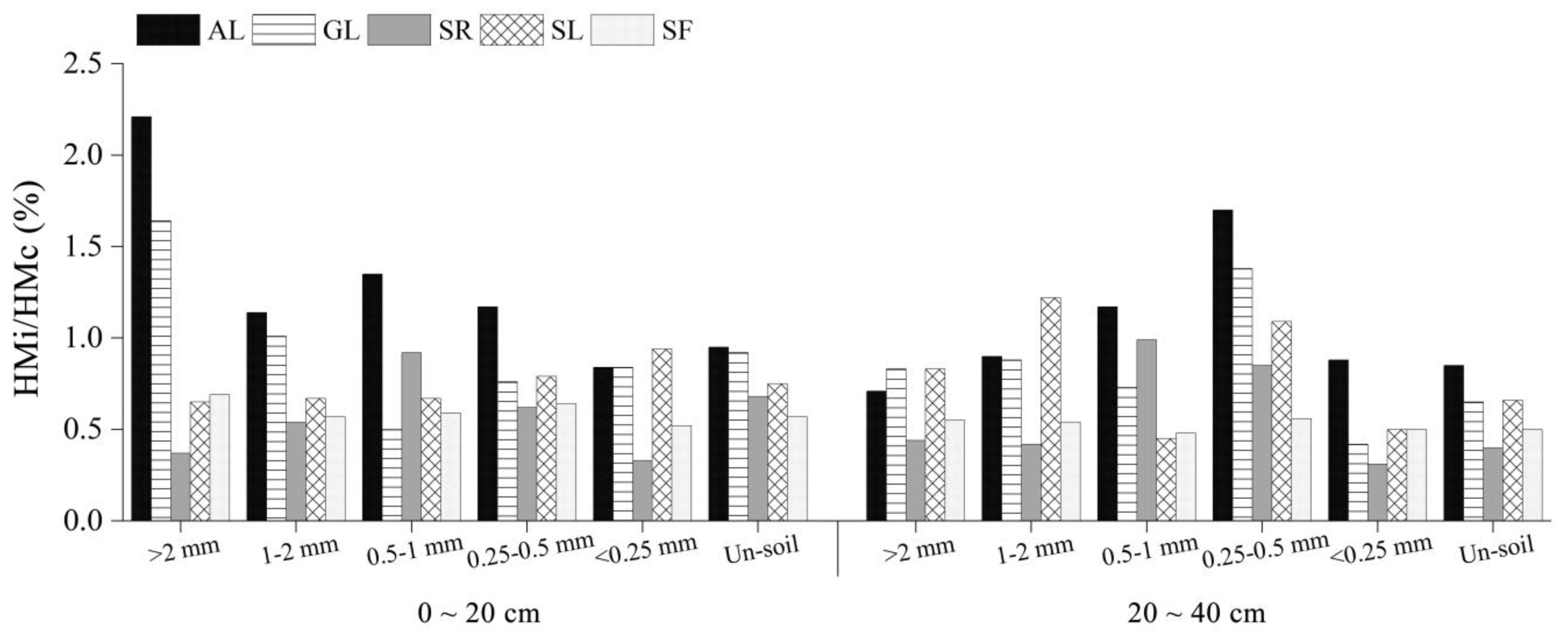

| Vegetation Type | Latitude | Longitude | Elevation (m) | Slope (°) | Main Predominate Trees |
|---|---|---|---|---|---|
| AL | 24°55′53″ | 107°57′31″ | 413~679 | 33~39 | Apluda mutica, Hosta plantaginea |
| GL | 24°55′16″ | 107°57′45″ | 407~587 | 38~42 | Miscanthus floridulus, Imperata cylindrica |
| SR | 24°56′40″ | 107°58′52″ | 389~502 | 40~47 | Coriaria nepalensis, Neyraudia reynaudiana |
| SL | 24°56′04″ | 107°59′19″ | 393~513 | 35~39 | Alchornea trewioides, Rhus chinensis |
| SF | 24°55′15″ | 107°58′05″ | 381~583 | 35~43 | Radermachera sinica, Toona sinensis, Gleditsia sinensis |
| Soil Depth (cm) | Vegetation Type | pH | BD (g·cm−3) | Soil Particle Size Distribution (%) | ||
|---|---|---|---|---|---|---|
| Sand | Silt | Clay | ||||
| (0.05–2 mm) | (0.002–0.05 mm) | (<0.002 mm) | ||||
| 0~20 | AL | 6.18 ± 0.07 b | 1.32 ± 0.01 a | 26.07 ± 0.37 a | 48.15 ± 0.15 c | 25.78 ± 0.22 b |
| GL | 6.22 ± 0.01 b | 1.30 ± 0.07 a | 15.26 ± 1.24 c | 60.26 ± 1.76 a | 24.48 ± 0.52 c | |
| SR | 6.49 ± 0.03 a | 1.16 ± 0.12 ab | 18.90 ± 0.40 b | 61.46 ± 0.13 a | 19.64 ± 0.26 d | |
| SL | 6.11 ± 0.09 b | 1.00 ± 0.15 bc | 15.22 ± 0.22 c | 53.00 ± 0.50 b | 31.78 ± 0.28 a | |
| SF | 6.09 ± 0.03 b | 0.92 ± 0.06 c | 26.49 ± 0.10 a | 41.99 ± 0.08 d | 31.52 ± 0.02 a | |
| 20~40 | AL | 6.64 ± 0.06 b | 1.37 ± 0.06 a | 23.52 ± 0.38 a | 48.22 ± 0.83 b | 28.26 ± 0.44 c |
| GL | 6.44 ± 0.06 bc | 1.38 ± 0.02 a | 14.49 ± 0.19 c | 59.27 ± 0.43 a | 26.24 ± 0.24 d | |
| SR | 6.91 ± 0.08 a | 1.35 ± 0.05 a | 13.73 ± 0.26 c | 58.51 ± 0.41 a | 27.76 ± 0.14 c | |
| SL | 6.30 ± 0.05 c | 1.06 ± 0.08 b | 19.67 ± 0.32 b | 47.76 ± 1.06 b | 32.57 ± 0.73 b | |
| SF | 6.25 ± 0.01 c | 1.04 ± 0.03 b | 22.53 ± 0.47 a | 41.52 ± 0.72 c | 35.95 ± 0.25 a | |
| Soil Depth (cm) | Vegetation Type | MWD (mm) | WSAs (%) | PAD (%) |
|---|---|---|---|---|
| 0~20 | AL | 1.48 ± 0.03 c | 74.02 ± 2.97 b | 19.65 ± 1.67 a |
| GL | 4.00 ± 0.13 b | 87.76 ± 0.10 a | 7.19 ± 0.95 a | |
| SR | 4.38 ± 0.05 ab | 87.14 ± 1.12 a | 10.47 ± 1.27 a | |
| SL | 4.55 ± 0.05 ab | 89.25 ± 1.22 a | 9.85 ± 3.10 a | |
| SF | 4.96 ± 0.54 a | 90.45 ± 8.02 a | 8.31 ± 1.72 a | |
| 20~40 | AL | 1.53 ± 0.06 c | 70.89 ± 3.28 c | 22.58 ± 2.31 a |
| GL | 3.93 ± 0.02 b | 82.45 ± 0.63 b | 13.22 ± 0.93 b | |
| SR | 4.08 ± 0.22 b | 86.19 ± 1.03 ab | 11.57 ± 1.01 b | |
| SL | 4.51 ± 0.21 a | 90.16 ± 0.99 a | 8.29 ± 1.38 b | |
| SF | 4.57 ± 0.21 a | 89.08 ± 1.53 a | 10.21 ± 1.08 b |
| Soil Depth (cm) | Vegetation Type | Average Weight Diameter MWD (mm) | RSI (%) | RMI (%) | ||
|---|---|---|---|---|---|---|
| FW | SW | WS | ||||
| 0~20 | AL | 2.44 ± 0.07 c | 2.97 ± 0.08 c | 2.88 ± 0.14 a | 0.18 ± 0.04 b | 0.03 ± 0.02 a |
| GL | 1.78 ± 0.15 d | 3.46 ± 0.02 a | 2.71 ± 0.77 a | 0.48 ± 0.04 a | 0.22 ± 0.22 a | |
| SR | 3.18 ± 0.04 a | 3.44 ± 0.01 a | 3.29 ± 0.05 a | 0.08 ± 0.01 cd | 0.04 ± 0.02 a | |
| SL | 2.78 ± 0.13 b | 3.07 ± 0.15 bc | 2.94 ± 0.14 a | 0.09 ± 0.04 c | 0.04 ± 0.02 a | |
| SF | 3.24 ± 0.12 a | 3.26 ± 0.14 ab | 3.18 ± 0.12 a | 0.01 ± 0.01 d | 0.03 ± 0.01 a | |
| 20~40 | AL | 1.76 ± 0.49 b | 2.78 ± 0.23 c | 2.89 ± 0.12 b | 0.36 ± 0.20 b | 0.04 ± 0.07 b |
| GL | 1.08 ± 0.15 b | 3.41 ± 0.05 a | 3.23 ± 0.09 a | 0.68 ± 0.05 a | 0.05 ± 0.03 ab | |
| SR | 2.89 ± 0.26 a | 3.46 ± 0.01 a | 3.22 ± 0.20 a | 0.16 ± 0.07 bc | 0.07 ± 0.06 a | |
| SL | 2.61 ± 0.41 a | 3.29 ± 0.08 ab | 3.14 ± 0.08 ab | 0.21 ± 0.12 bc | 0.05 ± 0.00 ab | |
| SF | 2.90 ± 0.15 a | 3.11 ± 0.04 b | 3.03 ± 0.09 ab | 0.07 ± 0.04 c | 0.03 ± 0.02 ab | |
| Index | Aggregates of Different Particle Sizes | |||||
|---|---|---|---|---|---|---|
| >2 mm | 1–2 mm | 0.5–1 mm | 0.25–0.5 mm | <0.25 mm | Un-Soil | |
| WSAs | 0.646 * | 0.619 | 0.542 | 0.546 | 0.633 * | 0.666 * |
| PAD | −0.565 | −0.520 | −0.443 | −0.455 | −0.563 | −0.583 |
| MWDFW | 0.584 | 0.609 | 0.549 | 0.624 | 0.557 | 0.615 |
| MWDSW | 0.054 | 0.023 | −0.047 | −0.039 | −0.005 | 0.056 |
| MWDWS | 0.253 | 0.316 | 0.276 | 0.255 | 0.103 | 0.234 |
| RSI | −0.573 | −0.603 | −0.563 | −0.631 | −0.564 | −0.604 |
| RMI | −0.109 | −0.199 | −0.240 | −0.214 | −0.045 | −0.090 |
| Index | Aggregates of Different Particle Sizes | |||||
|---|---|---|---|---|---|---|
| >2 mm | 1–2 mm | 0.5–1 mm | 0.25–0.5 mm | <0.25 mm | Un-Soil | |
| WSAs | 0.877 ** | 0.906 ** | 0.881 ** | 0.872 ** | 0.857 ** | 0.886 ** |
| PAD | −0.782 ** | −0.832 ** | −0.818 ** | −0.795 ** | −0.775 ** | −0.805 ** |
| MWDFW | 0.777 ** | 0.740 * | 0.779 ** | 0.759 * | 0.798 ** | 0.750 * |
| MWDSW | 0.295 | 0.414 | 0.365 | 0.286 | 0.282 | 0.295 |
| MWDWS | 0.345 | 0.331 | 0.238 | 0.167 | 0.253 | 0.235 |
| RSI | −0.709 * | −0.645 * | −0.698 * | −0.699 * | −0.736 * | −0.686 * |
| RMI | 0.064 | 0.192 | 0.228 | 0.212 | 0.134 | 0.157 |
| Index | Aggregates of Different Particle Sizes | |||||
|---|---|---|---|---|---|---|
| >2 mm | 1–2 mm | 0.5–1 mm | 0.25–0.5 mm | <0.25 mm | Un-Soil | |
| WSAs | 0.240 | 0.531 | 0.106 | 0.140 | 0.109 | 0.446 |
| PAD | −0.207 | −0.49 | −0.019 | −0.081 | −0.052 | −0.374 |
| MWDFW | 0.312 | 0.448 | 0.443 | 0.273 | 0.344 | 0.605 |
| MWDSW | −0.327 | −0.096 | −0.495 | −0.448 | −0.475 | −0.197 |
| MWDWS | −0.266 | −0.187 | −0.155 | −0.252 | −0.366 | −0.049 |
| RSI | −0.407 | −0.492 | −0.564 | −0.388 | −0.476 | −0.660 * |
| RMI | −0.062 | 0.123 | −0.354 | −0.226 | −0.143 | −0.114 |
| Index | Aggregates of Different Particle Sizes | |||||
|---|---|---|---|---|---|---|
| >2 mm | 1–2 mm | 0.5–1 mm | 0.25–0.5 mm | <0.25 mm | Un-Soil | |
| WSAs | 0.496 | 0.575 | 0.525 | 0.489 | 0.392 | 0.571 |
| PAD | −0.364 | −0.480 | −0.457 | −0.424 | −0.299 | −0.457 |
| MWDFW | 0.579 | 0.595 | 0.448 | 0.513 | 0.561 | 0.673 * |
| MWDSW | −0.170 | −0.042 | −0.144 | −0.087 | −0.047 | 0.003 |
| MWDWS | 0.213 | 0.070 | −0.053 | −0.031 | 0.222 | 0.273 |
| RSI | −0.622 | −0.619 | −0.493 | −0.543 | −0.575 | −0.674 * |
| RMI | −0.318 | −0.051 | −0.054 | −0.022 | −0.192 | −0.178 |
| Index | Aggregates of Different Particle Sizes | |||||
|---|---|---|---|---|---|---|
| >2 mm | 1–2 mm | 0.5–1 mm | 0.25–0.5 mm | <0.25 mm | Un-Soil | |
| WSAs | 0.766 ** | 0.728 * | 0.767 ** | 0.765 ** | 0.774 ** | 0.733 * |
| PAD | −0.679 * | −0.631 | −0.692 * | −0.697 * | −0.716 * | −0.637 * |
| MWDFW | 0.773 ** | 0.777 ** | 0.717 * | 0.683 * | 0.603 | 0.752 * |
| MWDSW | 0.194 | 0.174 | 0.259 | 0.262 | 0.310 | 0.144 |
| MWDWS | 0.307 | 0.393 | 0.360 | 0.333 | 0.362 | 0.329 |
| RSI | −0.726 * | −0.729 * | −0.653 * | −0.620 | −0.529 | −0.717 * |
| RMI | −0.015 | −0.110 | 0.006 | 0.027 | 0.049 | −0.087 |
| Component | Equation | R2 | F | p |
|---|---|---|---|---|
| HA-C | Y = 0.586X1 + 1.252 | 0.556 | 10.021 | 0.013 |
| FA-C | Y = 0.442X2 − 0.184 | 0.856 | 47.546 | 0.000 |
| HMc-C | Y = 1.163X2 + 1.343 | 0.418 | 5.741 | 0.043 |
| HMr-C | Y = 0.148X3 + 1.052 | 0.705 | 19.133 | 0.002 |
Disclaimer/Publisher’s Note: The statements, opinions and data contained in all publications are solely those of the individual author(s) and contributor(s) and not of MDPI and/or the editor(s). MDPI and/or the editor(s) disclaim responsibility for any injury to people or property resulting from any ideas, methods, instructions or products referred to in the content. |
© 2024 by the authors. Licensee MDPI, Basel, Switzerland. This article is an open access article distributed under the terms and conditions of the Creative Commons Attribution (CC BY) license (https://creativecommons.org/licenses/by/4.0/).
Share and Cite
Yang, Y.; Wei, H.; Lin, L.; Deng, Y.; Duan, X. Effect of Vegetation Restoration on Soil Humus and Aggregate Stability within the Karst Region of Southwest China. Forests 2024, 15, 292. https://doi.org/10.3390/f15020292
Yang Y, Wei H, Lin L, Deng Y, Duan X. Effect of Vegetation Restoration on Soil Humus and Aggregate Stability within the Karst Region of Southwest China. Forests. 2024; 15(2):292. https://doi.org/10.3390/f15020292
Chicago/Turabian StyleYang, Yuanfeng, Hui Wei, Liwen Lin, Yusong Deng, and Xiaoqian Duan. 2024. "Effect of Vegetation Restoration on Soil Humus and Aggregate Stability within the Karst Region of Southwest China" Forests 15, no. 2: 292. https://doi.org/10.3390/f15020292
APA StyleYang, Y., Wei, H., Lin, L., Deng, Y., & Duan, X. (2024). Effect of Vegetation Restoration on Soil Humus and Aggregate Stability within the Karst Region of Southwest China. Forests, 15(2), 292. https://doi.org/10.3390/f15020292







